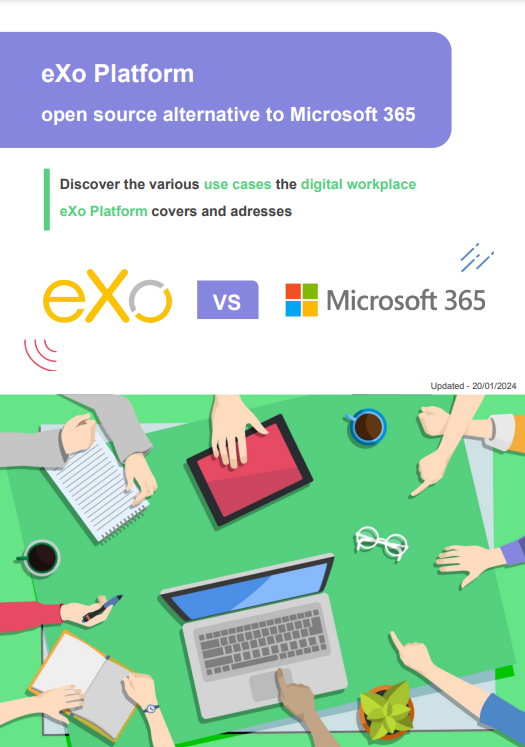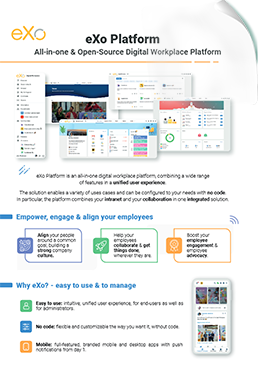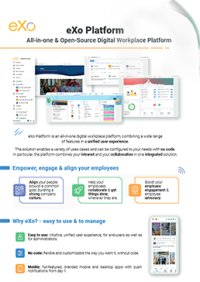


FREE WHITE PAPER
Discover, compare, and migrate to the best Workplace From Meta alternative
The Polytechnique school suspends its migration to Microsoft 365. The state of Schleswig-Holstein in northern Germany gives up Microsoft tools in favor of open source alternatives. The Occitanie region is gradually freeing itself from GAFAM.
Across Europe, public organizations are regaining control over their digital tools, but caution remains the done thing and action is still too rare.

According to a study by Asterès conducted on behalf of Cigref, annual purchases of cloud services and software by European companies that benefit the US economy amount to €264 billion. This technological dependence of France and Europe represents a huge cost: the equivalent of nearly two million jobs financed in the United States. Even today, digital sovereignty is too often just talk… and rarely action.
However, local authorities and public administrations hold the keys to change, and it is in the public sector that the first signs of a digital revival are emerging.
So how can we move from talk to action?
Long perceived as an abstract concept reserved for experts, digital sovereignty has become a strategic imperative. Geopolitical tensions, customs duties, rising cloud and software costs, cyberattacks explosion… Europe is becoming aware of its dependence.
The Cigref strategic report for 2040 sounds the alarm: French companies and the public sector remain heavily dependent on non-European suppliers for cloud services, infrastructure, collaborative software, and artificial intelligence. It is time to build true digital autonomy and move away from the role of mere consumer to become a player once again.
The decision of the Polytechnique school to stop its migration to Microsoft 365 sent a strong message.
For an institution under the authority of the French Armed Forces Ministry, entrusting its data to a player subject to US extraterritorial laws (particularly the Cloud Act and FISA) represented a major risk. Furthermore, this contract violated the L123-4-1 article of the French Education Code, which requires the priority use of free software in higher education and research.
Under pressure from actors such as the CNLL (Open Source National Council), Polytechnique’s management reversed its decision and returned to solutions compliant with the European framework.
As Stéfane Fermigier, president of the CNLL, pointed out: “The template of cloud solutions subject to US extraterritorial law is structurally incompatible with safeguarding our economic and strategic interests.”
This decision echoes that of the German state of Schleswig-Holstein, which migrated more than 40,000 Microsoft email accounts to open source tools (source: Siècle Digital).
These decisions mark the beginning of a political reappropriation of digital technology and lay the foundations for true digital autonomy. This autonomy is based on three inseparable dimensions.
Digital autonomy is not simply a matter of hosting data on national territory or favoring a European supplier. It is based on the ability of a country, administration, or local authority to choose, control, and govern its digital tools according to its own rules.
Digital autonomy is based on three closely linked pillars:
In short, digital autonomy is sovereignty made tangible: the ability of an organization to secure, govern, and develop its digital capabilities without depending on outside interests.
And this ambition is becoming a reality, driven in particular by the public service.

Workplace Migration Guide : Comparaisons, Plans and Testimonials
Discover, compare, and migrate to the best Workplace From Meta alternative



Discover, compare, and migrate to the best Workplace From Meta alternative
Although awareness remains low in France, the movement is growing. Organizations are often torn between the desire to take action and the fear of breaking with “comfortable” solutions. Many obstacles remain, such as inertia in purchasing processes, particularly in the public sector, dependence on proprietary ecosystems, and a lack of visibility on alternatives.
However, as the months go by, more and more initiatives are making headlines and showing a real change of direction. In most cases, it is local authorities and public administrations that are leading the way and paving the way for concrete digital sovereignty.
The Occitanie French Region, which counts 13 local governments and has a population of over 6 million, launched a digital independence strategy in 2023.
Faced with a 20-30% increase in costs on the previous contract with Microsoft, the region decided to replace the Microsoft 365 suite with the French open source solution eXo Platform, hosted in a SecNumCloud environment.
A pragmatic and gradual approach: start with collaboration, support change, train staff, and capitalize on field feedback. The results: an annual bill reduced by 4 and greater autonomy.
Today, the Region has defined a clear path forward: gradually phasing out GAFAM, focusing costly licenses on critical needs, and gradually expanding to collaborative messaging.
Recently, the Île-de-France Region took the gamble of moving away from Microsoft 365 and equipping its 550,000 high school students and teachers with French and sovereign solutions. This was a strong choice, motivated by the need to protect the data of underage students from extraterritorial laws, the sharp rise in Microsoft’s prices, and the desire to reinvest in the local digital ecosystem.
This initiative shows that it is possible to combine performance, accessibility, and sovereignty without compromising on user experience.
The French City of Lyon has also taken the plunge by gradually replacing Microsoft Office with open source office tools and creating a free and interoperable collaborative suite.
The aim is to strengthen the security and technological sovereignty of the public service, control costs, extend the life of IT equipment, and reduce the environmental footprint.
Lyon is thus taking a pragmatic approach: giving meaning back to its digital choices, limiting its dependence on major American suppliers, and putting sovereignty back at the service of operational efficiency.
In Marseille, the IT department is pursuing an ambitious open-source software policy focused on user experience. The goal is to bring open-source performance in line with that of proprietary tools, while reducing technological dependencies.
Marseille is not simply replacing one tool with another: the city is rethinking its digital strategy as a whole, focusing on training, sharing, and local innovation.
This approach shows that it is possible to combine freedom, performance, and quality public service.
This movement is not limited to large local authorities. Across France, medium-sized and smaller cities are also committing to sovereign and responsible digital technology.
The French cities of Chelles, Clichy-sous-Bois, Lunel, and Rumilly have chosen open source and sovereign solutions, proving that it is possible to take action at their own level.
Europe is not far behind. In Germany, the state of Schleswig-Holstein is leading the way with the migration of 40,000 Microsoft Exchange accounts to open source tools (Nextcloud, LibreOffice, Open-Xchange, eXo Platform, etc.). Its goal is to regain control of its public infrastructure and ensure data protection faced to extraterritorial US laws.
In Denmark, the cities of Copenhagen and Aarhus are following the same path by gradually moving away from the Microsoft ecosystem and experimenting with open, interoperable, and European solutions.
These initiatives, whether they come from a large region, a medium-sized city, or an administration, remind us that sustainable digital autonomy is built collectively, through cooperation, reversibility, and transparency.

Open Source Alternative to Microsoft 365
Empower your organization with eXo Platform to break free from Microsoft dependencies and enhance collaboration with innovative solutions
Open Source Alternative to Microsoft 365
Empower your organization with eXo Platform to break free from Microsoft dependencies and enhance collaboration with innovative solutions
Digital sovereignty is a collective responsibility. But how can this principle be turned into reality? Here are five concrete steps to initiate a sustainable and realistic transformation.
Start with a detailed assessment of the current situation. Identify the software, cloud services, tools, and infrastructure that depend on non-European actors. Focus first on areas of high strategic value such as collaboration, messaging, and office automation. Assess the associated risks (legal, economic, security) and prioritize the most critical areas.
The goal of this step is to understand your exposure and the associated risks in order to plan a realistic and gradual transition.
Public procurement is a powerful lever for steering digital technology toward greater sovereignty. Systematically include criteria for sovereignty, interoperability, GDPR compliance, and reversibility in your calls for tenders.
The goal is to make every purchase a strategic act, not just a technical and administrative one.
Adopting an open approach also means preserving local competitiveness, strengthening the resilience of public services, and ensuring data control.
The goal is to support a sustainable ecosystem and create value in the area.
As the African proverb says, “alone we go faster, together we go further.”
The challenge is to act together and pool resources, tools, use cases, and best practices. Build on initiatives as well as existing associations and networks, which are leading the way and structuring cooperation.
The goal is to create a collective public intelligence in the service of sovereignty.
Digital sovereignty is not just a technical issue; it is also, and above all, a cultural change. Training employees, elected representatives, and decision-makers to understand digital issues is essential.
Raising awareness, explaining, and promoting local successes: this is how the trust needed to bring about lasting change in practices is built.
The goal is to make every public actor an ambassador for digital sovereignty.
Digital sovereignty is no longer a distant horizon. It is a reality in the making, driven by a collective, cultural, and political project that France and Europe are already embodying.
From France, Germany and Denmark, examples are multiplying and proving that a freer, more ethical, and more sustainable digital world is possible without compromising on innovation and performance.
Europe has talented people, tools, and convictions. All that remains is to take the plunge and turn words into action!
Want to break your dependence on GAFAM and set up an open source, sovereign intranet or collaborative platform? Contact us.

eXo Platform : The Open-Source
Digital Workplace Platform
Download the eXo Platform Datasheet and discover all the features and benefits


Download the eXo Platform Datasheet and discover all the features and benefits
( Your e-mail address will not be published)
I am the communication manager at eXo Platform. I found myself in communications a bit by chance, but this field brings together everything that pationates me: creativity, energy, meetings, collaborative work, sharing and exchanges of good practices. I need to give meaning to what I do and put people at the center of all my actions.